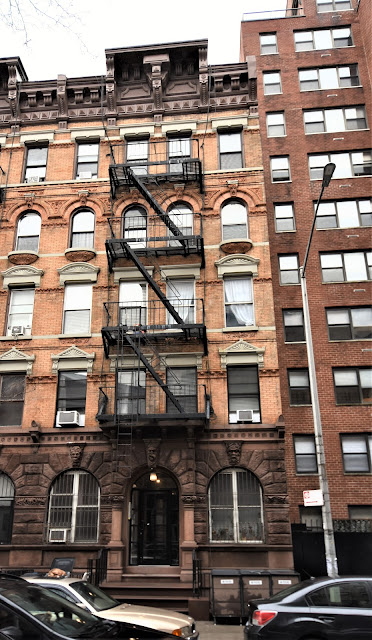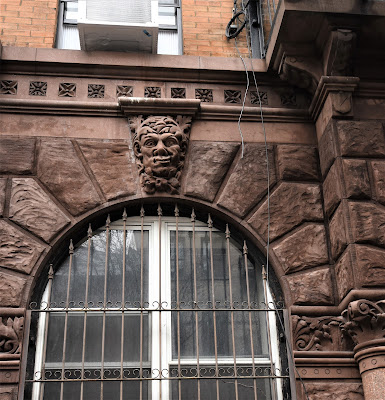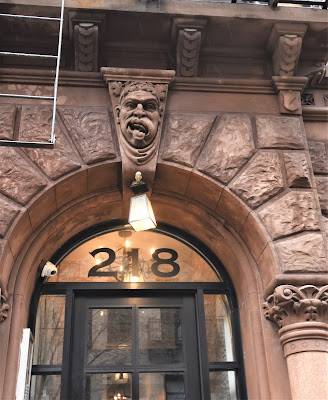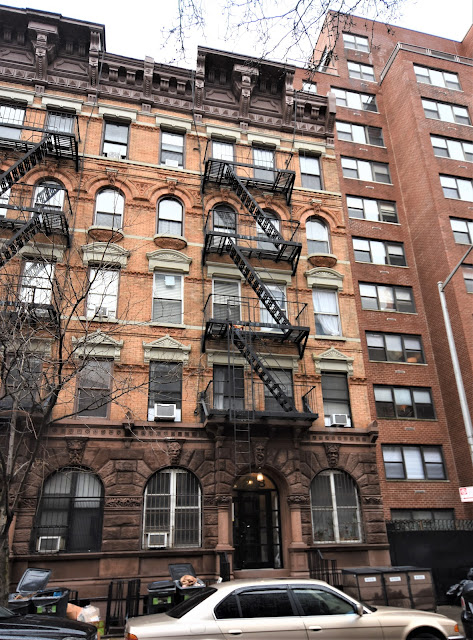In March 1890, Louis M. Jones purchased the four, four-story stores and tenements at 218 through 224 for $65,000--about $1.9 million in today's money. Two months later, the Real Estate Record & Guide commented, "Louis M. Jones, of Hoboken, N. J., is quite active in the purchase of down-town lots suitable for improvement." Jones would not thoroughly carry out this project, however. On May 28 he sold the properties to Justus H. Zimmerman for $70,500, reaping a satisfying quick profit. In reporting the sale, the Record & Guide noted, "new buildings projected."
Zimmerman hired Charles Rentz to design his tenement buildings. The architect was responsible for the sprawling Webster Hall on East 11th Street, completed three years earlier. The five story structures were designed in the Romanesque Revival style. Like its identical neighbors, the base of 218 East 27th Street was faced in undressed brownstone. The centered entrance above a short stoop was flanked with polished granite columns with brownstone capitals. While the other first-floor portrait keystones along the row took the shape of expected "green men" and Vikings, these are tongue-in-cheek.
Rentz decorated the brick-faced upper floors with terra cotta and stone elements and capped the row with ambitious pressed metal cornices.
Expectedly, the four-room apartments filled with working class tenants. One, named Duffy, placed a detailed position-wanted advertisement in the New York Herald on August 3, 1902:
Coachman, medium sized, thoroughly experienced' unsurpassed personal recommendations from prominent families; skillful driver; smart appearance; temperate, obliging, industrious, respectful, trustworthy. Duffy. 218 East 27th
Hansom cab driver Max Kaufmann and his wife, Mary Emma, lived here at the time with their three young children. For extra income the Kaufmanns took in a boarder, Adolph Koenig. But a flirtation between Mary Emma and the boarder soon enraged Kauffman. The New-York Tribune reported, "Owing to Koenig's attentions to Mrs. Kaufmann, Kaufmann had ordered the boarder to leave the house. He had done so, but had returned."
It was the last straw for Kaufman, who now ordered his wife to leave. Mary Emma and Koenig moved into a flat at 319 West 40th Street in March 1904. The romance quickly deteriorated. According to a neighbor, Harry Haas, "the man and woman often quarreled, and that more than once he had heard Koenig threaten to kill her."
On the night of May 2, just two months after they moved into the apartment, Haas heard them quarreling again. He told police, "There was a stormy time." At one point Koenig slammed a door "so loudly that it shook the house." Haas and his wife said they assumed that "the quarrel would be fought out and that the couple would go to sleep." That did not happen.
The following morning Koenig's cries drew attention. He was found on the floor with a stab wound in his abdomen. Mary Emma's body lay near him. Koenig, who was "suffering greatly," explained to detectives that he had gone out for some beer and when he returned around midnight, he found Mary Emma dead. He then decided to commit suicide and stabbed himself with a butcher knife.
The evidence, however, refuted his story. Marks on Mary Emma's throat "indicated that she had struggled fiercely before she died," and the cause of her death was determined to be strangulation. Koenig was arrested on a charge of attempting suicide. At hearing the news back at 218 East 27th Street, Max Kauffman was resigned. The New-York Tribune reported he "said last evening that such a termination of his wife's relations with Koenig was not unexpected by him."
Other tenants had similar, respectable jobs. Edwin Saville was an elevator operator at the Siegel-Cooper department store, for instance; and Luke Monahan was a bartender looking to improve his lot in 1907. That year he filed for a position as patrolman with the New York Police Department.
George McGee, who worked as a compositor in a printing firm, was involved in a frightening incident on May 18, 1916. That evening at around 6:00 he sat at the lunch counter at Karn's Café in Brooklyn. Sitting next to him was former Long Beach Chief of Police Charles W. Hewlett. When Joseph Blommer handed McGee his sandwich, he refused it, saying the meat was too fat. Blommer then offered it to Hewlett, who also refused it.
Blommer became enraged. The South Side Observer reported, "Angry words ensued and the lunchman...seized a long and sharp carving knife and slashed Hewlett with it five times. One blow nearly severed the former police chief's nose. Another cut the back of his neck. The third sweep of the blade opened his left cheek, the fourth his forehead, while the last took a piece of one ear."
At this point McGee "interfered" and he, too, was slashed on the face. Finally, other patrons were able to subdue Blommer and hold him until a policeman arrived. McGee appeared in court as a witness against the attacker on May 25.
John McCartney, who lived here in 1917, was the manager of the Lincoln Giants baseball team. On April 27, The New York Times reported that he and three other men were arrested and "charged with violating the Sabbath law by indulging in a game of baseball on Sunday." In court, Inspector Morris testified that he had received a complaint from the New York Sabbath Society that games were being played in the park at 138th Street and Fifth Avenue.
Unfortunately for the amateur players, Sundays were about the only days game could be held. Most worked six days per week, having only Sunday off. He told the judge that the previous Sunday he had taken a squad of plain clothed officers to the park and watched a game between the Lincoln Giants and the Bronx Eagles. The patrons paid a few cents at the gate for a score card. The offense was considered serious. McCartney was held in $100 bail--a significant $2,000 in today's money.
A month before the incident, on March 20, President Woodrow Wilson had declared war on Germany. Later that year a five-mile parade of troops heading off to war was viewed by more than 2 million New Yorkers along Fifth Avenue. Among them was Mary Flynn, who lived at 218 East 27th Street. It is possible that her son was among the boys marching, but for whatever reason, she was overcome. The New York Herald reported that she was afflicted with "hysteria," attended to by a physician in a nearby house, and taken home.
One tenant who fought was James E. McGuire who departed for France on April 6, 1918 with the 308th Infantry.
The demographics of the Kips Bay neighborhood was changing by the Depression Years. The tenants' surnames, once German and Irish, now represented a wide-variety of ethnicities. Living here in 1934, for instance, was the Sumpandian family. That summer Rose Sumpandian and her five-year-old daughter, Surie, had the bad luck to be on the southbound Second Avenue bus that skidded on wet pavement and smashed into an elevated railroad pillar at 37th Street. They and 11 other passengers were injured, although not seriously.
Other than replacement windows, the building is remarkably little changed since 1891. And it's whimsical portrait keystones are worth a pause.
photographs by the author
no permission to reuse the content of this blog has been granted to LaptrinhX.com






.png)
Another great article.
ReplyDeleteSecond paragraph, last sentence. I believe you meant "unexpected" instead of "expected."
Glad you enjoyed it. No, actually the green men and Vikings were normal, or expected, motifs. It was the other two examples which were unexpected.
DeleteSorry. My bad.
DeleteIf the situation in NYC was like that in Albany NY many of the sandstone carvers were of Scots /Irish ancestry or were trained by someone who was.
ReplyDelete